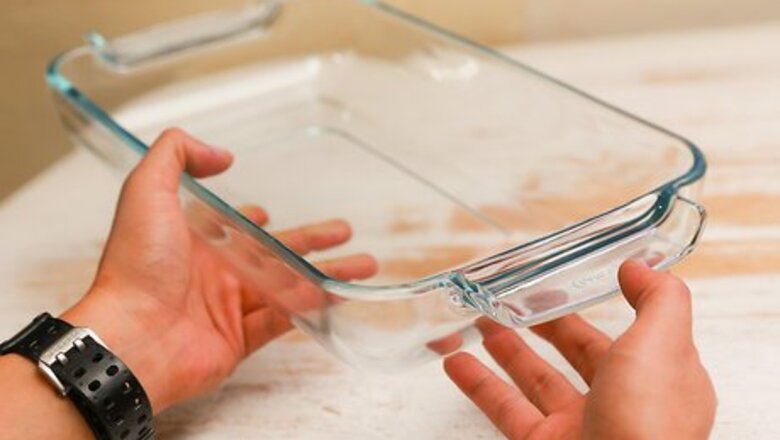
views
Learning the Basics

Get a good-quality casserole dish. Casseroles are made by combining a variety of starches, meats, vegetables, and other ingredients, sometimes raw and sometimes cooked, into the dish and baking them in a casserole dish. Casserole dishes are traditionally square or rectangular baking pans, usually made of Pyrex, aluminized steel, or earthenware. Often, casseroles are quite hearty, topped with cheese or breadcrumbs.
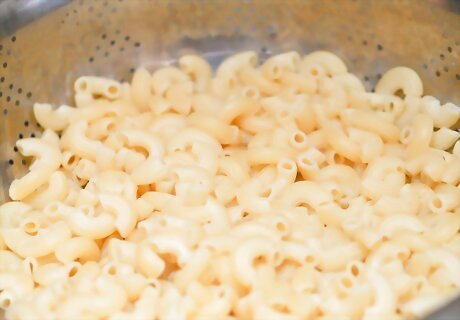
Choose a starch. Most casseroles use as their base some variety of starch, which will form the most substantial content of the casserole. Typically pre or par-cooked before being added to the casserole dish, using starches as a base is a good way to stretch a little bit of protein or vegetables into a full meal. While casseroles are amenable to any variety of ingredients, most tend to use the following: Potatoes. Pre-cooked potatoes can make an excellent base for breakfast or dinner casseroles, or as a topping to shepherd's pie in it's mashed form. If you want to use potato in your casserole, you can purchase frozen hash browns or parboil peeled and quartered raw potato until fork-tender. It goes especially well with beef, or other red meats. Pasta. From egg noodles to mostaccioli, pasta makes a perfect base for a casserole. Mixed with any variety of sauce or cheese, pasta casseroles can be made both sweet and savory, perfect for any time of the year. Lasagna is the classic of the genre, but experiment with different pastas to find what you like best. Rice. Common in both Middle Eastern and Midwestern American cuisine, rice-based casseroles go particularly well with chicken or other poultry. Basic white rice is good to start with, but wild rice, jasmine rice, or even black rice can make casseroles surprising and complex. Other grains. Why stop at rice? Quinoa, barley, wheat berries, oatmeal, or any combination of whole grains can make a substantial and healthy casserole, especially when combined with rice. Egyptian koshari, which can be made as a casserole, features pasta, lentils, and rice as an idiosyncratic base for its spices and flavors. Why not?

Choose a meat, vegetable, or a combination of the two. For most casseroles, you'll sauté the proteins and vegetables briefly in a skillet, then finish them off in the casserole dish, topped with breadcrumbs or cheese. For that reason, you can almost think of a casserole like a stir fry that you bake at the end. Chicken and other meats should be cooked through before being added to the casserole dish. Casserole recipes that feature a lot of liquid, however, will sometimes call for raw meat to be added to cook everything at the same time. It's possible to do both. Carrots, onions, and other root vegetables make excellent additions to any casserole. Because everything is cooked together, casseroles are an excellent way to spice up somewhat bland vegetables. For vegetarians, green or brown lentils make an excellent substitution for the meat in most casserole recipes. Commercial meat substitutes, like seitan or tofu-based meat alternatives are amenable to the casserole as well.
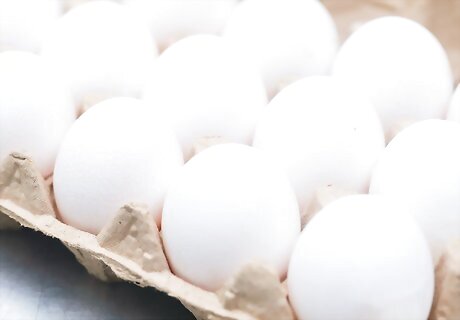
Choose a binder that will keep everything together. For lots of casseroles, a sauce or egg mixture will be added to the ingredients to keep everything bound together. In Midwestern cuisine, this often takes the form of Cream of Mushroom soup, but béchamel, curry, whipped egg, pasta sauce, or other ingredients are likewise common, depending on the ingredients used.

Sautee the ingredients and combine in a greased casserole dish. Meats should be cooked through and vegetables should have the crunch taken off, but should still be somewhat firm before being added to the casserole dish. Before adding ingredients, it's a good idea to grease the pan with butter or oil. Depending on the casserole, you might like to layer the ingredients into separate layers, as with a lasagna or a moussaka, or mix the ingredients.

Bake covered for the majority of the cooking time. Depending on the topping you use and the kind of texture you're looking for, it's common to cover your casserole with aluminum foil or a lid, and bake between 350 and 425 F. The cooking time will vary, depending on the ingredients and the amounts. For casseroles in which all the ingredients are cooked ahead of time, and you're just trying to melt cheese, you only need 10 or 15 minutes in the oven to finish the job. If you want to cook rice in liquid, you're looking at a cooking time closer to 45 minutes or an hour.
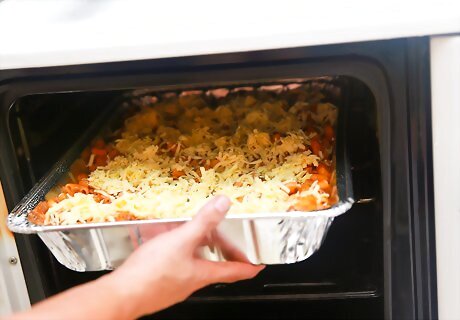
Uncover the casserole and add the topping, then broil to finish it. If you want a cheesy or crunchy top to your casserole, don't add it ahead of time, or it'll be a soggy mess. Wait until you've cooked the casserole through, then remove the cover, add your topping, and broil the casserole to finish it. Common toppings include: shoestring potatoes French onions parmesan cheese potato chip crumbs cracker crumbs mashed potato
Making Pasta-Based Casseroles
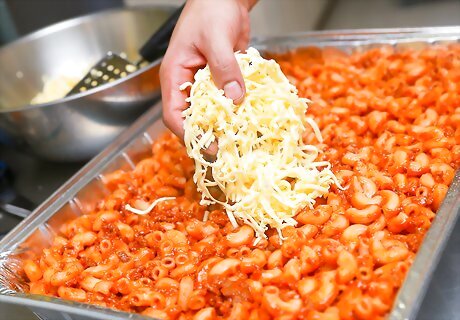
Make baked macaroni and cheese. One of the easiest and most delicious simple casseroles to make is a baked macaroni and cheese. By varying the ratio of cheese-to-macaroni, you can make yours gooier or more firm, depending on how you like it. Boil half a box of macaroni for a square-shaped casserole dish and a full box for a rectangular dish. Cook until al dente, then rinse with cool water to stop them from cooking and put them in a greased casserole dish. In a skillet, heat 2 tablespoons (29.6 ml) of butter over medium heat, then whisk in about two tablespoons of flour and brown it to make the roux, while it clumps up. Keep stirring it, or it'll burn quickly. When it browns, add 2 cups of whole milk, a little at a time, whisking vigorously, to integrate the flour and thicken things. Add salt and pepper to taste after the milk has been added, and let the roux thicken. When it bubbles, add about 8 oz. of shredded sharp cheddar cheese, or whatever kind of cheese you like, melting the cheese in. Cheddar is most common, but mix it up by adding half cheddar and half pepper jack, or mozzarella. Use your favorite kind. Pour the cheesy mixture over the noodles in the casserole dish. Common additions might include sautéed mushrooms, ground beef or sausage, raw tomato slices, onions and garlic. Bake at 350 for 15 minutes, then top with breadcrumbs or parmesan cheese and broil to finish. If you like your mac and cheese creamier, add more milk at the beginning, and use fewer noodles. If you like it firmer, make less sauce, enough to just coat the noodles and add a significant amount of breadcrumbs to the top.
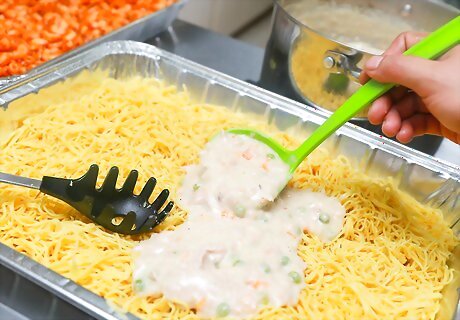
Make tuna casserole. Tuna casserole, or tuna-noodle casserole, is Midwestern cooking at its commonest. Using egg noodles, canned tuna, and cream of mushroom soup, it's a quick and hearty meal that you can derive from cheap pantry ingredients. Boil two cups of egg noodles until al dente, and rinse them in cool water to stop the cooking. In the casserole dish, mix one can of cream of mushroom soup with a half cup of water, one drained can of solid white albacore tuna, and a cup and a half of frozen peas. Salt and pepper to taste. Alternative additions might include cheddar cheese, chopped pimento or black olive, frozen carrots, or using canned salmon instead of tuna. Bake at 400 degrees for about half an hour, then remove to add breadcrumbs and parmesan cheese for a topping. Broil to finish.

Make lasagna. To make a basic lasagna, you can layer cooked lasagna noodles, mozzarella, parmesan, or ricotta cheese (or, better yet, all three) and marinara sauce in a casserole dish and bake until the cheese is melted and warm and delicious. Sauté any additional vegetables and meat you'd like in your lasagna before adding sauce to the skillet. Spinach, mushrooms, eggplant and sausage are all common additions. Layer noodles, then sauce mixture, then cheese until you fill the pan. It's common to top lasagna with a beaten egg and parmesan cheese to create a nice golden crunch on top. Lasagna should be baked covered at 375 F for 25 minutes and then remove the cover and bake an additional 25 minutes. Before cutting into it, let it stand for 15 minutes.
Making Rice-Based Casseroles

Make turkey with wild rice casserole. A great way to revitalize leftover poultry is to cook it up as part of a casserole with fragrant wild rice and vegetables. One of the great things about cooking a rice-based casserole is that you have the option of cooking the rice in the oven, alongside the other ingredients, or you can use pre-cooked rice in the casserole if you've got it on hand. This option is available for any rice-dish you make in the oven. Sauté two strips of chopped bacon in a skillet over medium heat. Add half a white onion, chopped, and a few cloves of minced garlic, to your taste. When the onion is translucent, stir in two chopped carrots (about a cup), a stalk of chopped celery, and about a pound of turkey breast, cut into bite-sized chunks. Brown the turkey, cooking about 2 or 3 minutes. In your casserole dish, add a cup of wild rice, or whatever kind of rice you like, with 2 1/2 cups of water, a can of condensed cream of mushroom soup, and a sprinkling of a half-teaspoon each of marjoram, thyme, and rosemary. Add a teaspoon of salt and pepper to taste, then mix in the chicken mixture and stir thoroughly. Bake covered at 375 for about 30 minutes. Remove when the rice is cooked and the liquid has mostly evaporated. Additions or substitutions might include chicken or other poultry for turkey, and the addition of frozen peas, water chestnuts, pimento, fresh chopped mushrooms, green beans, or asparagus. Add whatever you like, and remove what you don't. Cream of chicken soup would also be perfectly effective to use as a thickener, or you could leave out the soup altogether and use a cup of cream or milk.
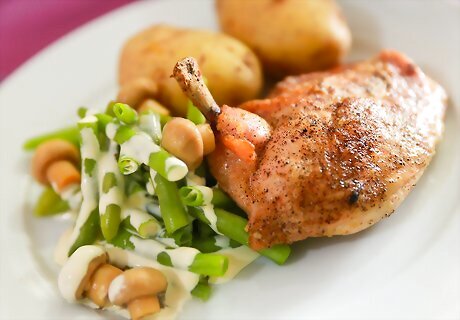
Make a chicken biryani casserole. Most commonly associated with Indian cuisine, biryani is actually a Persian dish, originally. While not traditionally prepared as a casserole, mixing curried chicken and cooked basmati rice in a casserole dish can be a nice change of pace from the cream of mushroom tradition. It smells delicious and tastes even better. To make the rice, fry half a small white or yellow onion in butter (or clarified butter, called ghee) with a bay leaf, two cracked cardamom pods, and a tsp. of whole cloves (5-10 cloves). Add three cups of basmati rice and stir in the spicy butter until it becomes translucent, then add about 6 cups of water and cook over low heat, covered, for about 40 minutes, or until all the water is absorbed. Remove from the heat and set the rice aside. If you don't have the whole spices, substitute two tsp. of powdered spice. To marinade the chicken, marinade 6 or 7 chicken drumsticks and thighs in a mixture of coconut milk (about a quarter cup) with chopped cilantro and mint (about a half-cup of each), a tablespoon of dried cumin, a tablespoon of dried coriander, and half a bulb of chopped garlic. Make little slits in the chicken, then rub with the marinade and let sit in the refrigerator overnight. To make the curry, fry a whole chopped white onion in butter or ghee and add 5 cloves of minced garlic and a two-inch piece of ginger, chopped. Add 5-7 whole cloves, a cinnamon stick, a tsp. of turmeric, a tablespoon of dried cumin, tablespoon of dried coriander powder, and a tsp. of gram masala. Stir the onion and dried spices together for about a minute so it doesn't burn, then add a cup of coconut milk, two cups of water, and stir everything together thoroughly to mix. When it boils, add the chicken, then cover and cook over medium-low heat for 30 minutes until the chicken is cooked through. To assemble, line the bottom of the casserole dish with half the rice, then top with the chicken and curry sauce. Add the rest of the rice on top, cover with foil, and bake at 350 F for about 40 minutes. Check about halfway through the cooking time to make sure the rice isn't drying out.
Making Vegetable Casseroles

Make green bean casserole. A savory staple of many a Midwestern American holiday meal, green bean casserole is a creamy baked side dish made with few ingredients. If there was ever a recipe that cream of mushroom made necessary, it is this. To mix it up, mix together about 4 cups of cooked green beans, cut into bite-sized pieces, and one can of condensed cream of mushroom soup. Stir in about a half cup of milk, a few dashes of soy sauce, to taste, and salt and pepper to taste. Line the mixture in a greased casserole dish and bake at 350 F for about 20 minutes until it gets warmed through and bubbling. Top with about a cup of fried French onions and let them brown in the oven for about five minutes. Serve hot.
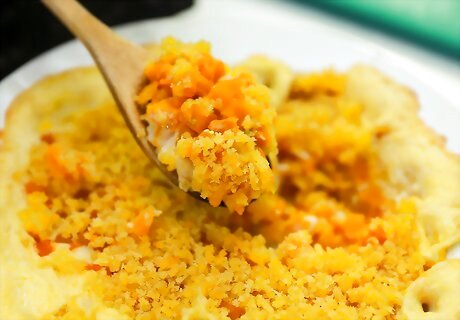
Make summer squash casserole. Summer squash like yellow crookneck or zucchini have a tendency to be pretty bland on their own, but baked up with cheese and crunchy topping can take them to the next level. Cut up about 4 cups of squash (roughly 2 medium squash) and sauté them over medium heat in some olive or coconut oil and half a chopped onion, then combine with ¾ of a cup of water, 2 beaten eggs, a cup of shredded cheddar cheese (or whatever kind of cheese you prefer), and salt and pepper to taste. Mix the ingredients thoroughly and spread into a casserole dish. Top the mixture with crunched up cracker crumbs, or breadcrumbs if you prefer, dotted with a tablespoon of butter. Bake at 400 F for 20 minutes, or until golden and firm. Additions or substitutions might include cherry tomatoes, fresh dill, basil, or other summer herbs, and bacon. The same recipe would also work for winter squash that had been par-baked, and would be great combined with other root vegetables like sweet potato and carrot.
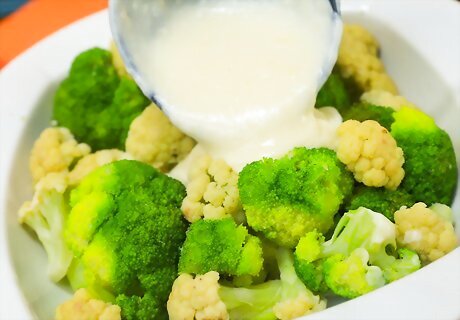
Make broccoli-cauliflower casserole. To liven up cruciferous vegetables, you can't go wrong with cheese. Thickened with a simple roux and baked under breadcrumbs, it's a delicious, if not super-healthy, way to eat your broccoli. Start by chopping a head of broccoli and about half a head of cauliflower into bite-sized pieces, or by defrosting a package of each, if you want to use the frozen variety. Sautee half an onion over medium heat in butter, then add two tablespoons of flour to start the roux. Stir vigorously, browning the flour, then add about two cups of milk, whisking to thicken. When it bubbles and gets thick, add a quarter-cup of parmesan cheese and a half a package (about 4 oz) of cream cheese. Season with a teaspoon each of thyme, oregano, and dill. If you like a little kick, this works great with about a quarter teaspoon of cayenne, as well. Toss the broccoli and cauliflower in the cheese mixture and spoon into a casserole dish. Top with breadcrumbs and a sprinkling of parmesan cheese, then bake at 350 F for about 40 minutes.
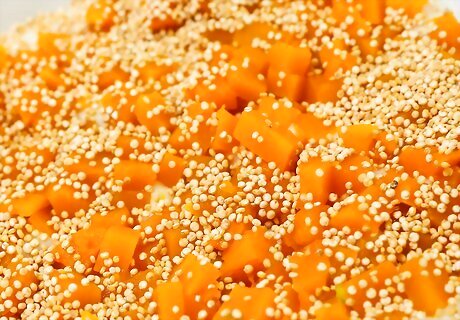
Make roasted winter squash and quinoa casserole. A common complaint about vegetable casseroles is that the cheese and cream outweighs the nutritional benefits of the vegetables. While cream-of-mushroom and other varieties of cheesy casserole may taste good, there are perhaps more nutritional ways of preparing vegetables. Mixing quinoa--a perfect protein, as well as a delicious and hearty grain--with hearty roasted butternut squash fits the bill of healthy and tasty casserole. Roast one medium-sized butternut squash at 400 F, after slicing it in half and scooping out the seeds. Drizzle a little olive oil on top of the squash and roast in a roasting pan for about 20 minutes, until soft. If you'd prefer chunks of squash, rather than mashed, you can peel the squash and chop it into bite-sized chunks before roasting. In a hard-bottomed pot, sauté half an onion, chopped, with 2-3 cloves of minced garlic in olive oil. When the onion is translucent, add a teaspoon of dried sage, or a tablespoon of fresh chopped sage, and one cup of quinoa. Stir to coat the quinoa, then add a cup and a half of water. Bring the quinoa to a boil, then simmer over medium-low heat, covered, for about fifteen minutes, until all the water is absorbed. Add salt and pepper to taste, then stir in a cup and a half of chopped spinach or kale, a quarter cup each of dried cranberries and chopped walnuts, and two beaten eggs. In a greased casserole dish, combine the quinoa mixture with the roasted squash. If you want, you can add a half cup of shredded swiss cheese, on top or mixed in, or leave the cheese off entirely if you wish. Return to the oven and bake for about 40 minutes.
Making Regional Casseroles
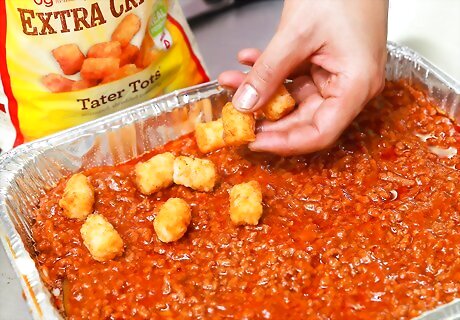
Try tater-tot hotdish from the American Midwest. It doesn't get any more Midwestern than tater tots and ground beef. It also doesn't get any easier or more nostalgic. Childhood comfort food at its finest. Brown a pound of lean ground beef over medium-high, seasoning to your taste. If you like it a little spicy, add some chili powder or cayenne. It's also common to add garlic and onions. Add a can of condensed cream-of-mushroom soup, when the meat is cooked, and add two cans of whatever vegetables you like. Green beans are common, as well as peas, corn, or some combination of the above. Frozen vegetables are likewise fine. Spoon the ground beef mixture into a casserole dish and top with a bag of frozen tater-tots, then bake at 350 degrees for about an hour, or until the tater tots are golden brown and crispy. Serve it up with tabasco, and it's winter in Minnesota.
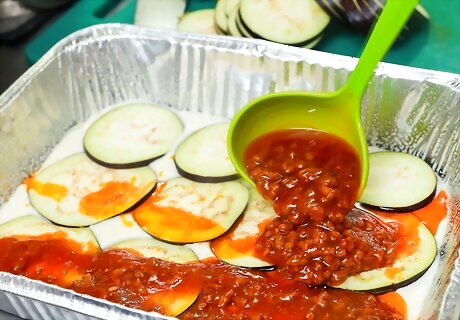
Make Mediterranean moussaka. Moussaka is a lot like lasagna, but with potato and eggplant instead of noodles, and meat sauce and béchamel instead of marinara and mozzarella. It's delicious. Start with a basic meat sauce, made with a pound of browned ground beef, garlic, and onions, spiced with cinnamon and oregano, as well as salt and pepper to taste. Add a half cup of red wine, a half can of tomato paste, and some lemon zest. Simmer uncovered for about 20 minutes, then turn off the heat. Peel 2-3 small-to-medium eggplant, and 2-3 medium-sized potatoes, then slice into equal rounds, about a quarter-inch thick. Boil the potato rounds in salted water for about 7 minutes, until fork-tender, and grill the eggplant slices, or sauté them in the skillet to cook them through. It's usually best to salt the eggplant and allow them to sit for about 15 minutes before cooking them, to release some of the moisture. In a skillet, make a roux by whisking about a half-cup of flour in about a half stick of butter over medium heat, then thicken with 3-4 cups of milk, whisking vigorously. In a separate bowl, beat two eggs, then slowly add them to the hot mixture, once thickened, to temper it. Add nutmeg and salt, to taste. Layer the bottom of a casserole dish with potato rounds, eggplant rounds, and meat sauce, alternating however you wish. Top the mixture with some parmesan cheese, if you wish, and the white sauce, then bake at 350 for about 45 minutes, until the top is nicely browned.
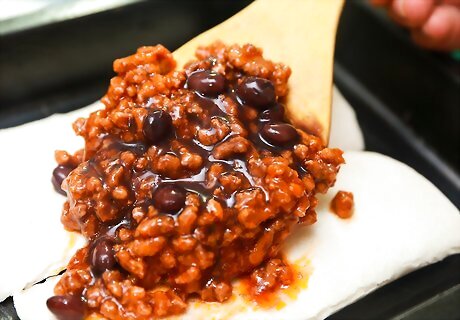
Make Southwestern black bean casserole. For a tortillas-and-black beans variant on lasagna, you can mix up a spicy casserole with hearty black beans, chorizo, and chili sauce. Brown up a pound of chopped chorizo in a skillet over medium-high heat, then remove. If you don't like chorizo, regular sausage would be a fine alternative. In the same skillet, sauté a chopped onion and 2-3 cloves of minced garlic, adding two teaspoons of ground cumin and one of cinnamon, when the onions become translucent. Add about three cups of cooked black beans to the skillet, with a cup of chicken stock, and return the chorizo to the mix. Reduce the heat and simmer for about 10 or 15 minutes, testing for salt. In a casserole dish, spoon some green chili sauce on the bottom, then layer several corn tortillas in a layer on top. Spoon some of the black bean mixture over the tortillas, then add a sprinkling of shredded monterey jack cheese, or the cheese of your choice. Continue alternating layers until the dish is full, and top with extra shredded cheese. Bake covered for 20 minutes and uncovered for another 20, at 350. Serve with sour cream.
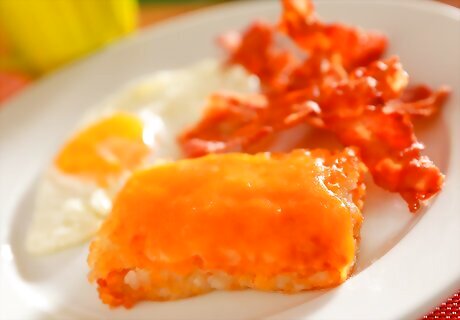
Make southern hash-brown casserole. It may not be healthy, but it's the cornerstone of a country breakfast. Next to fried eggs and a bowl of hominy grits, it's hard to beat cheesy hash-brown casserole. In a mixing bowl, combine a cup of sour cream, a half cup of melted butter, a can of condensed cream-of-mushroom soup, 2 cups of shredded cheddar cheese (or your favorite cheese), and a teaspoon each of salt and pepper. Mix together thoroughly, then stir in two pounds of shredded potatoes. It's common to use the frozen kind for this dish, but if you shred up your own, rinse the shredded potato in water and squeeze them out thoroughly before adding. Spoon the mixture into a casserole dish, and top with the secret weapon: crumbled corn flakes cereal. Bake uncovered for 40 minutes, or until golden brown and bubbly.
Making Dessert Casseroles
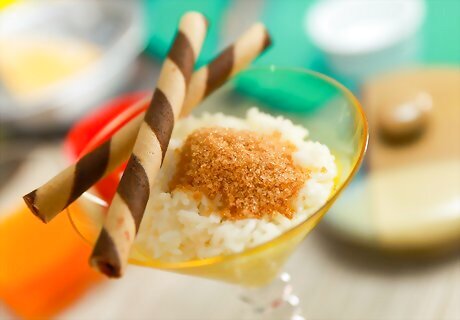
Make rice pudding in a casserole dish. Casseroles and starches don't always have to be savory. Baked rice pudding makes a wonderful finish to a meal that's spicy and light on starch. To make rice pudding: In a casserole dish, combine a cup of cooked white rice (or brown rice, if you prefer the texture), with two cups of milk and one of water, two beaten eggs, a half-cup of brown sugar, and a quarter cup each of chopped walnuts, and raisins (or whatever fruits and nuts you prefer). Season with nutmeg, a pinch of cinnamon and salt, and a half teaspoon of vanilla. Bake at 325 F for 30 minutes, or until golden brown. Check for doneness by sticking a kitchen knife into the center of the casserole, which should come out clean. You can substitute the spices for others as you prefer.
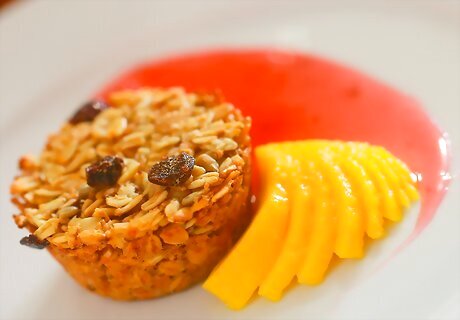
Make baked oatmeal. Oatmeal can be prepared the night before and popped into the oven in the morning for a wonderfully warm and comforting breakfast. It's perfectly amenable to whatever fruits, nuts, and additions you like in your oatmeal. In a mixing bowl, combine a cup of raw oats, two cups of milk, and a cup of water. Mix in a half cup of brown sugar and a teaspoon of cinnamon. Add whatever nuts and dried fruits you like, or leave them out entirely. Cover with plastic wrap and refrigerate overnight. In the morning, spoon the oatmeal into a casserole dish and bake at 350 for about half an hour, or until golden brown, with the edges bubbling. Halfway through the cooking top, remove the oatmeal, and top with slices of fresh fruit and a sparkling of cinnamon-sugar. Sliced peaches, apples, or pears are all appropriate.

Make bread pudding. A great way to liven up stale bread is to mix up a bread-based casserole. While bread-puddings can be sweet or savory, the dessert variety is the most well-known, particularly in southern cuisine and BBQ cooking. In a casserole dish, tear up at least 6 slices of stale bread, or about half a loaf. In a separate bowl, beat 3 eggs and mix in 2 cups of milk, a half cup of brown sugar, and a teaspoon each of vanilla and cinnamon. Add a quarter cup each of chopped nuts, or dried fruits that you enjoy. Pour this mixture over the bread, and bake at 350 for about 45 minutes, or until springy. Test with a kitchen knife in the center, which should come out clean. To make a savory bread pudding, substitute your favorite shredded cheese for the sugar, and dried sage, oregano, and rosemary for the cinnamon.




















Comments
0 comment